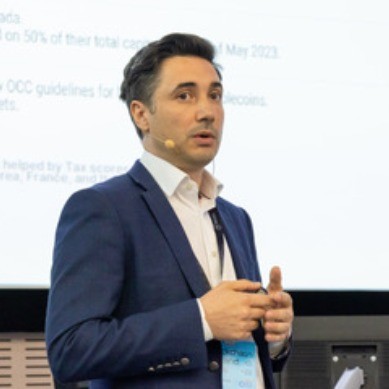What to Expect at El Salvador Digital Assets Summit 2025
The Digital Assets Summit 2025 takes place on April 29 at the Hilton in San Salvador. Organized by the National Digital Assets Commission (CNAD), the event brings together global regulators, compliance experts, and industry builders for a full day of panels and closed-door sessions.
El Salvador enters its third year since adopting Bitcoin as legal tender and establishing a dedicated digital assets regulator, the first of its kind globally. What many thought to be a “controversial experiment” has since evolved into a formal regulatory model, one that continues to draw attention from countries weighing similar paths.
This year’s summit lands at an important time. MiCA is being phased in across the EU. The U.S. is caught between enforcement-heavy action and stalled legislation. FATF pressure on non-compliant jurisdictions is rising. In that environment, El Salvador is making itself as a case study in regulatory design.
El Salvador’s Position in the Global Crypto Landscape
El Salvador remains the only country with a dedicated digital assets regulator. Since forming the CNAD, the country has moved quickly to draft, implement, and enforce crypto-specific rules across issuance, custody, and market participation. Its regulatory body now ranks second globally, an important position for a country often left out of the mainstream financial narrative.
What started as a political experiment has since turned into a full institutional framework. CNAD licenses digital asset service providers, enforces compliance standards, and provides legal clarity where many jurisdictions still operate in a grey zone. This structure has drawn interest from countries in Latin America, Africa, and Southeast Asia, all places where traditional finance has failed to deliver access or innovation.
While many governments are still debating how to define crypto, El Salvador has already built the legal machinery to regulate it. That early move now allows it to host a summit not just as a participant, but as a model others are beginning to study.
What’s on the Agenda This Year
The agenda at DAS 2025 is structured around the practical needs of both regulators and operators. Panels cover foundational topics like licensing frameworks, AML enforcement, and compliance architecture, which are all core areas where El Salvador has already passed legislation and begun implementation.
Law enforcement plays a central role in this year’s discussions. Sessions focus on real-world crypto crime, sanctions evasion, and how countries are approaching travel rule compliance. Investigators, prosecutors, and compliance officers from several jurisdictions will share insights from ongoing cases and cross-border operations.
On the infrastructure side, the event explores how regulation intersects with product design. Topics include tokenized instruments, risk logic in blockchain data, and the growing complexity of VASP structures across multi-jurisdiction platforms.
Global cooperation is another theme. Speakers from Latin America, Europe, and North America are expected to discuss how different regions align through bilateral agreements and joint enforcement mechanisms. Several sessions are also dedicated to the legal pathways for Memorandums of Understanding (MOUs) between regulators and private sector actors.
Several panels feature women in leadership roles across legal, investigative, and technical backgrounds, alongside contributors from across Latin America, Canada, and Europe.
Who Will Be There
More than 40 speakers and moderators are confirmed for DAS 2025, representing a wide mix of public institutions, private firms, and investigative bodies.
From the policy side, attendees will hear directly from Juan Carlos Reyes, President of CNAD, and Carlos Aguilar, Director of Legal Affairs. Both have been central to shaping El Salvador’s regulatory model and are expected to provide updates on its next phase.
El Salvador went from the Bitcoin experiment to hosting the world’s best-regulated digital asset market.
– Zero tax on crypto
– $150B+ in assets
– A dedicated commission, not legacy regulatorsThey didn’t adapt; they rebuilt.
Dive in: https://t.co/GIcY9HiVEE pic.twitter.com/U2UabwlTvT— Coincub (@Coincub_) April 2, 2025
In the field of compliance and enforcement, several experienced investigators will join the program. Nick Furneaux of TRM Labs brings expertise in blockchain forensics, while Aidan Larkin and Erin Plante from Asset Reality will speak on asset tracing and recovery in crypto-related investigations.
Industry representation includes Peter Warrack of Bitfinex, one of the few crypto firms with deep regulatory engagement across jurisdictions. Speakers like Koleya Karringten from the Canadian Blockchain Consortium and Lory Kehoe from Blockchain Ireland will offer views from mature and emerging regulatory environments.
Other sessions highlight voices from outside the traditional financial centers. Fernando Arriola, representing Paraguay’s fintech initiative, and Muhammad Jiya, a regional infrastructure executive, will contribute perspectives from markets where digital assets are already playing a structural role in financial inclusion and modernization.
Why DAS 2025 Is Worth Attending
DAS 2025 is a policy benchmark. While many global events focus on product demos or speculative narratives, this summit centers on regulation, enforcement, and long-term infrastructure. For governments still drafting frameworks or struggling to enforce existing ones, it looks at how digital asset policy can be structured, implemented, and monitored in practice.
El Salvador’s model may not be universally replicable, but it’s become a reference point for developing economies that see potential in building parallel financial rails. The presence of regulators, investigators, and infrastructure builders in the same room makes this event unusually well-rounded since each side of the ecosystem is accounted for.
Many of the discussions taking place in San Salvador are likely to shape how FATF guidelines get interpreted regionally. For countries watching the rollout of MiCA in Europe or waiting on U.S. policy direction, DAS provides a space to test ideas, compare notes, and align on what a functioning digital asset economy should look like.
DAS 2025 arrives at a time when digital asset regulation is no longer theoretical. This year’s summit offers a clear view into where crypto policy is heading and how compliance, access, and innovation will have to coexist going forward.




